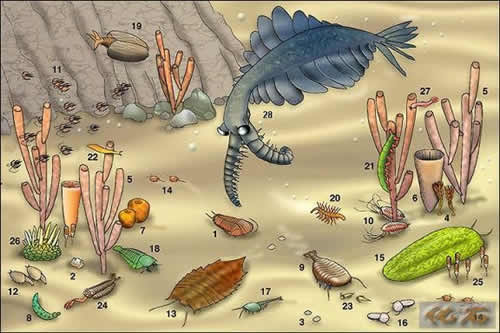"The Burgess Shale included a range of disparity in anatomical designs never again equaled, and not matched today by all the creatures in the world's oceans," Gould wrote.
“布爾吉斯頁巖化石所包含的橫剖面的花色范圍是獨一無一的,今天世界海洋里所有的生物加起來也無法與之匹敵。”古爾德寫道。
Unfortunately, according to Gould, Walcott failed to discern the significance of what he had found. "Snatching defeat from the jaws of victory," Gould wrote in another work, Eight Little Piggies, "Walcott then proceeded to misinterpret these magnificent fossils in the deepest possible way." He placed them into modern groups, making them ancestral to today's worms, jellyfish, and other creatures, and thus failed to appreciate their distinctness. "Under such an interpretation," Gould sighed, "life began in primordial simplicity and moved inexorably, predictably onward to more and better."
不幸的是,據古爾德說,沃爾科特沒有看到自己的發現的重要意義。“沃爾科特把到手的勝利丟了”,古爾德在另一部作品《八只小豬》中寫道,“接著便對這些了不起的化石作出了最錯誤的解釋。”沃爾科特用現代的辦法來對它們進行分類,把它們看成為今天的蠕蟲、水母和其他生物的祖先,因此沒有認識到它們的不同之處。“按照這種解釋,”古爾德嘆息說,“生命以最簡單的形式開始,然后不可阻擋地、可以預測地朝著更多、更好的方向發展。”

Walcott died in 1927 and the Burgess fossils were largely forgotten. For nearly half a century they stayed shut away in drawers in the American Museum of Natural History in Washington, seldom consulted and never questioned. Then in 1973 a graduate student from Cambridge University named Simon Conway Morris paid a visit to the collection. He was astonished by what he found. The fossils were far more varied and magnificent than Walcott had indicated in his writings. In taxonomy the category that describes the basic body plans of all organisms is the phylum, and here, Conway Morris concluded, were drawer after drawer of such anatomical singularities—all amazingly and unaccountably unrecognized by the man who had found them.
沃爾科特于1927年去世,有關布爾吉斯化石的事在很大程度上已經被人遺忘。在將近半個世紀的時間里,那些化石被鎖在華盛頓美國自然史博物館的抽屜里,很少有人去查看,根本無人問津。1973年,劍橋大學一位名叫西蒙·康韋·莫里斯的研究生花錢參觀了那批收藏品。他被眼前的化石驚呆了。這些化石要比沃爾科特在他著作中提到的壯觀得多,品種也多得多。在分類系統中,描述生物體基本橫剖面的類別是門。而在這里,康韋·莫里斯得出結論,是一抽屜又一抽屜如此奇特的橫剖面——都是那位發現者不知何故沒有認識到的,真是令人不可思議。












